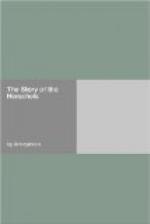“The light of the head had a bluish-green tint.” Was this a real tint, or did the central reddish body, only through contrast, make the surrounding vapour appear to be coloured? Herschel did not examine the question from this point of view.
“The head of the comet appeared to be enveloped at a certain distance, on the side towards the Sun, by a brilliant narrow zone, embracing about a semicircle, and of a yellowish colour. From the two extremities of the semicircle arose, towards the region away from the Sun, two long luminous streaks which limited the tail. Between the brilliant circular semi-ring and the head, the cometary substance appeared to be dark, of great rarity, and very diaphanous.
“The luminous self-ring floated: one day it seemed to be suspended in the diaphanous atmosphere by which the head of the comet was surrounded, at a distance of 322,000 English miles from the nucleus.
“This distance was not constant. The matter of the semi-annular envelope seemed even to be precipitated by slow degrees through the diaphanous atmosphere; finally, it reached the nucleus; the earlier appearances vanished; the comet was reduced to a globular nebula.
“During its period
of dissolution, the ring appeared sometimes
to have several branches.
“The luminous shreds of the tail apparently underwent rapid, frequent, and considerable variations of length. Herschel discerned symptoms of a rotatory movement both in the comet and its tail; a movement which carried unequal shreds from the centre towards the border, and the border towards the centre. On examining at intervals the same region of the tail—the border, for example—sensible changes of length must have been perceptible; which, however, had no reality in them. Herschel thought that both the comet of 1811 and that of 1807 were self-luminous. The second comet of 1811 appeared to him to shine only by borrowed light. It must be acknowledged that these conjectures did not rest on anything demonstrative.
“In attentively comparing the comet of 1807 with the beautiful comet of 1811, relative to the changes of distance from the Sun, and the modifications resulting thence, Herschel put it beyond doubt that these modifications have something individual in them,—something relative to a special state of the nebulous matter. On one celestial body the changes of distance produce an enormous effect, on another the modifications are insignificant.”
We have reproduced these observations by a distinguished French astronomer, in order to show the reader what was the nature, and how great was the importance, of Herschel’s labours, and in how remarkable and comprehensive a manner he conducted his survey of the celestial phenomena. We now return to our brief narrative of his life.
Such a life, absorbed in tranquil and incessant studies, presents no curious, romantic, or surprising incidents. It was the life of a reverent, patient, gentle, and devoted man of genius, who dedicated himself to the task of making known the “wondrous works of God” to his fellow-men, and who in all his social and domestic relations was without blot or stain.




